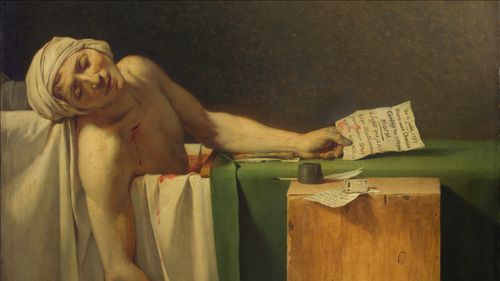The Power Behind David's 'The Death of Marat': Art, Martyrdom & Revolution
Mar 07, 2024 · 2 mins read
0
Share

Jacques-Louis David's "The Death of Marat" immortalizes a revolutionary martyr, capturing the tragic demise of Jean-Paul Marat, a radical journalist during the French Revolution, in a hauntingly serene composition.
Save
Share
Painted in 1793, this masterpiece is not just art; it's political propaganda, glorifying Marat as a hero of the people, his lifeless body reminiscent of a saintly figure, bathed in ethereal light.
Save
Share
Marat's murder, at the hands of Charlotte Corday, a figure from the opposing political faction, is depicted with a stark simplicity that belies the turbulent times it represents.
Save
Share
David transforms Marat's small, makeshift wooden bathtub, where he spent hours due to a skin condition, into an altar of sacrifice, elevating his death to martyrdom.
Save
Share
The inclusion of Marat's last letter, clutched in his hand, serves as a poignant reminder of his dedication to the revolutionary cause, even in his final moments.
Save
Share
Unlike traditional martyrdom paintings, David chooses to focus on the solitude of Marat's death, eschewing the chaos of the assassination for a moment of quiet dignity.
Save
Share
The painting's stark contrasts and minimalistic setting draw the viewer's eye directly to Marat's figure, emphasizing his role as a symbol of the Revolution's ideals and its costs.
Save
Share
David's personal connection to Marat, both as a friend and political ally, infuses the work with a palpable sense of loss and idealism, making it a deeply personal tribute.
Save
Share
"The Death of Marat" has transcended its time, becoming a symbol of political martyrdom and the power of art to immortalize ideals, inspiring countless interpretations and discussions.
Save
Share
This iconic work remains a testament to the complexities of revolution, the sacrifices of its leaders, and the enduring power of art to capture the essence of human struggle and idealism.
Save
Share
0